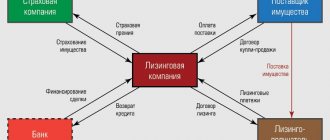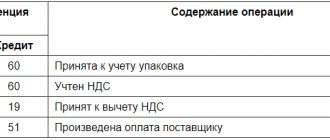Tire accounting principles
The main accounting parameters are: (click to expand)
- their number;
- model;
- tire brand;
- price;
- size.
Based on these indicators, accounting employees keep separate records of seasonal, summer and winter vehicle tires. At the same time, new and used spare parts are also taken into account separately. The purchase, their transfer into operation and other operations are reflected by the accounting service with account assignments (postings).
| Operation name | Accounting assignments |
| Buying a tire for a vehicle | DT 60, CT 51 (transfer of money for purchase), DT 10, subaccount “Spare parts” (“Spare tires”, “New tires”), KT 60 (financial obligations for purchased spare parts), DT 19, CT 60 (VAT on the cost of purchased goods), DT 68, CT 19 (VAT deductible) |
| Putting the tire into use | DT 10, sub-account “Spare parts” (“Tires in the sub-report”), KT 10, sub-account “Spare parts” and “Spare tires” |
| Disposal of a car tire due to its failure | DT 20 (26, 44), CT 10, subaccount “Spare parts”, “Tires in the sub-account” |
The cost of purchased vehicle tires for the purpose of replacing worn-out ones is displayed by the accounting service on account 10 “Materials”, subaccount “Spare parts”.
Tire registration card
Enterprises must keep track of consumables needed to operate their vehicles. One of the areas of accounting is control over the movement of tires. The accounting card records the receipt, operation and disposal of spare parts. It needs to reflect information about each unit of elements. It is written down which vehicle the part is assigned to. Monthly monitoring of operation is carried out. To do this, marks about the mileage of the car are placed. These marks allow you to track the technical condition of the elements. Based on this, it is determined whether the spare parts can be used further.
The card is filled out by the designated person. All information is entered based on the decisions of the expert commission. The composition of the latter is determined by the head of the enterprise.
FOR YOUR INFORMATION! Is it necessary to have a card? Yes, this is a mandatory requirement for all businesses. Only those who transport cargo or passengers for personal needs may not have cards.
Tax accounting of tires
When purchasing a car, the price of installed and spare tires is combined with the initial cost of the vehicle (Tax Code of the Russian Federation, Article 257). These spare parts do not appear on the accounting accounts as separate objects. Tires purchased separately are not included in the purchased vehicle and are not added to its cost. Here, tax accounting of spare parts is regulated by the Tax Code of the Russian Federation:
- Art. 254 (payer’s expenses for production and economic needs);
- Art. 260 (restoration of fixed assets);
- Art. 264 (maintenance and use of official transport).
So, for example, according to tax legislation, separately purchased spare parts can be taken into account as material expenses for the purchase of materials necessary for the maintenance of fixed assets. That is, tires in such cases are considered spare parts for a car, which are recorded at their cost among inventories. Expenses for their repair can be classified as other.
Expenses are considered for tax purposes in the tax period valid at that time. All expenses under the accrual method are recognized at the time the tires are assembled on the car. Spare parts removed from vehicles are not considered returnable waste or residual stock.
Who keeps the tire log?
The following accounting entries were made in the accounting records of Avtodor LLC: Debit 10 “Materials” subaccount 5 “Spare parts” Credit 60 “Settlements with suppliers and contractors” - 8,000 rubles.
— a set of summer tires was received at the warehouse; Debit 19 “VAT on purchased assets” Credit 60 “Settlements with suppliers and contractors” - 1440 rubles. — the amount of “input” VAT is reflected; Debit 68 “Calculations for taxes and fees”, subaccount “VAT” Credit 19 “VAT on acquired values” - 1440 rubles.
— the amount of “input” VAT is presented for tax deduction; Debit 26 “General business expenses” Credit 10 “Materials” subaccount 5 “Spare parts” - 8000 rub. — tires are installed on a passenger car.
Seasonal tires that were removed from the vehicle due to the change of season must be entered into the warehouse. The procedure for recording such transactions is not provided for by accounting regulations.
23 journal of registration and write-off of tires
Enterprises that have motor vehicles on their books must keep records of all consumables necessary for the operation and maintenance of the proper technical condition of the transport. One type of accounting is monitoring the movement of car tires.
Receipt, operation and disposal are recorded by drawing up a card for recording the operation of a car tire. This control method allows you to determine the entire range of application and use of the resource. The document reflects data on each unit of car tire, and also indicates which vehicle it is assigned to.
For monthly control of operation, notes on the vehicle's mileage are made in the accounting card.
In this way, the technical condition of the resource is monitored and it is determined whether further use of the tires is possible.
“card n __ tire operation accounting” (form n 424-apk)
Tires have to be changed frequently. Firstly, they wear out quickly on Russian roads. Secondly, they need to be changed for the winter and summer seasons. Thirdly, unexpected damage to tires occurs - punctures, cuts.
Let's consider the features of document flow for the receipt, release and movement of tires, as well as the procedure for accounting and taxation of their value. Car tires vary in their purpose, design, tread pattern, climate design and dimensions.
According to these indicators, car tires can be of the following types:
- tires for permanent use (all-season tires);
- tires for periodic use (winter and summer tires).
The latter have better performance properties, but in order to save money, organizations often use all-season tires on cars.
Tire operation card
Important The work record card indicates the technical condition of the tire on the vehicle (defects, nature and extent of damage). For used tires, when installed on another vehicle, their previous mileage is recorded.
After repairing local damage, the tire operation continues to be recorded using the same card.
The actual mileage is entered into each tire performance card every month.
When replacing a tire on the road wheels with a spare tire, the driver is required to inform the person responsible for tire performance records the date of tire replacement and the number of the tire removed and installed. This data is reflected in the cards for recording the operation of the replaced and spare tires.
Tires should not be taken out of service and handed over for scrap or refurbishment if their technical condition is suitable for further use.
Accounting for car tires in a government agency
As a result, a taxable temporary difference arises in the amount of 3,600 rubles, on the basis of which a deferred tax liability is formed: Debit 68 “Calculations for taxes and fees” subaccount “Calculations for income tax” Credit 77 “Deferred tax liability” - 960 rubles. (RUB 4,800 x 20%) - a deferred tax liability has been formed.
Tire accounting
The cost of tires returned to the warehouse is calculated using the formula: Cost of tires returned to the warehouse = ( Tire mileage rate - Actual mileage ): Tire mileage rate x Tire purchase price In other words, if the cost of a new set of car tires (4 pieces) is 40,000 rubles .
, the mileage rate in the organization is set at 50,000 km, then after actual operation (mileage) of 15,000 km and shift, this set of tires must be entered into the warehouse, reflected in the accounting entry: Debit 10.5 Credit 25 - 28,000 rubles.
– 4 car tires were capitalized ((50,000 km – 15,000 km): 50,000 km) x 40,000 rub.).
Car tire accounting
Attention Accounting for car tires and batteries V.Yu.
Galenko, chief accountant of Transelektromontazh OJSC, full member of the IPB of the Moscow region Continuing our consideration of the issue [1] of organizing accounting in companies with a large fleet of motor vehicles and special equipment, we will dwell on the features of accounting for such expensive consumables as car tires and batteries.
Accounting for car tires Car tires are not an eternal resource, and if the usage rate established by the manufacturer is exceeded or if they are damaged, they must be replaced. To control the use of tires, organizations can install (clause 3 of the Guidelines for accounting of inventories (approved.
Accounting for seasonal car tires (Korshunova N.)
For separate accounting, auxiliary subaccounts of the third order are opened to the subaccount “Spare tires”.
Tires of motor vehicles of the working capital (in the sub-report) are accounted for separately from those that are listed in the warehouse.
Tax accounting of tires When purchasing a car, the price of installed and spare tires is combined with the initial cost of the vehicle (Tax Code of the Russian Federation, Article 257).
These spare parts do not appear on the accounting accounts as separate objects. Tires purchased separately are not included in the purchased vehicle and are not added to its cost. Here, tax accounting of spare parts is regulated by the Tax Code of the Russian Federation:
- Art. 254 (payer’s expenses for production and economic needs);
- Art. 260 (restoration of fixed assets);
- Art.
Features of accounting for seasonal, summer and winter tires on vehicles in 2021
For tax purposes, tire repair costs can be taken into account as other costs associated with production and sales.
It should be noted that at present there are no regulatory documents establishing cost standards for restoring wear and tear and repairing car tires.
That is why these costs are the costs of carrying out routine repairs, which are included in the cost of products, works, and services as the costs of maintaining fixed assets in working condition.
However, rationing of these expenses is not provided. If tires have damage that cannot be repaired locally or restored by applying a new tread, then, by decision of a special commission created at the enterprise, they are written off as scrap.
Such tires are brought to the warehouse by weight at list prices, at which they are delivered to tire repair plants. The form, as stated above, can be developed independently or you can use the form given in Appendix No. 12 to Rules No. AE 001-04 (see on p. 28).
After the end of the service life of car tires, as a rule, for reasons that can be found in Appendix No. 9 to the Rules for the operation of car tires (AE 001-04), in the Decree of the Government of the Russian Federation dated October 23.
1993 No. 1090 “On the Rules of the Road” (together with the Basic Provisions for the admission of vehicles to operation and the duties of officials to ensure road safety), data from registration cards is transferred to statements (acts) for the write-off of car tires, on the basis of which accounting reflects these facts of the economic life of organizations.
- procedure for monitoring the rational use of car tires.
As a rule, the primary accounting documents for registering the movement of car tires in an organization are:
- documents on acceptance and receipt of car tires;
- various cards or records of car tires issued for use;
- statement (act) for writing off car tires.
Purchased car, bus tires, tires for agricultural vehicles, motorcycles and scooters must have a certificate (letter of the Federal Agency for Technical Regulation and Metrology dated April 29.
2011 No. A3-101-32/3615 “On products subject to mandatory confirmation of conformity (in the form of mandatory certification) in the GOST R certification system, indicating regulatory documents establishing mandatory requirements”).
Thus, production costs (or sales costs) of the current reporting period are reduced by the amount of tires returned to the warehouse.
An organization can independently determine the cost of tires removed from wheels by setting operational mileage standards, focusing on the technical characteristics of the corresponding tires.
You can also focus on the Temporary standards for the operational mileage of vehicle tires RD 3112199-1085-02.
On the one hand, the norms were abolished back in 2004. On the other hand, by decision of the commission of the Ministry of Transport of Russia dated April 18, 2006, their validity was again extended until the relevant technical regulations came into force (information letter of the Ministry of Transport of Russia dated December 7, 2006 No. 0132-05/394).
Source: https://yuridicheskaya-praktika.ru/kto-vedet-zhurnal-ucheta-raboty-avtoshin/
Accounting documentation for tire operation
A specialized accounting form of the card is created by the technical service of the relevant division of the organization according to form No. 424-APK separately for each vehicle tire (new, used or refurbished).
The main purpose of the registration card is to document the movement of tires in use from the time they are assembled until they completely fail. The card contains the following information: (click to expand)
- date of manufacture, manufacturer, price, as well as the name of the wheels and serial number;
- technical condition (existing defects, damage);
- mileage (the previous one is for used tires, and the actual mileage for each month is for all types of tires);
- date of tire replacement, numbers of removed and reassembled tires;
- dismantling time, total mileage, tread pattern data, for what purpose and for what reason it was taken out of service (in case of deregistration of the tire).
The specified standard accounting forms are filled out completely and stored according to vehicle numbers, and are closed when the spare part is sent for disposal.
The reason for writing off or replacing a tire is not its mileage if its technical condition is satisfactory and requires modernization, reconstruction, repair, or further operation. After restoration, other cards are issued for vehicle spare parts. In isolated cases, when there are no such cards, you can get some information from the waybill, which is issued for the vehicle.
How to capitalize car tires in accounting
An enterprise has the right to develop its own “primary” accounting forms for the receipt and issue of tires, as well as establish the procedure for filling them out. The company's management establishes a list of employees responsible for the acceptance and transfer of tires into operation, and approves the procedure for controlling the use of these assets.
For each tire installed on a vehicle (new, used, refurbished), it is necessary to create a work record card using standard form No. 424-APK, card No. M-17 for accounting for inventory items, or developing another form acceptable to the company. Initially, information about the tire and any defects is entered into it, and then the mileage values are filled in monthly. Upon completion of operation, it indicates the reasons and date of dismantling, mileage, further direction of the tire - for restoration, repair, scrap, etc. Often the card replaces the act of writing off the tire and confirms the need to put another tire into service.
Operating mileage rate for write-off
Russian legislation does not establish specific standards for the write-off of vehicle tires. With regard to their operational mileage, the regulations of the Ministry of Transport of the Russian Federation, set out in Letter No. 03-01/10-2830sh dated 08/24/2012, apply. Thus, according to the letter, the standards are determined by the manufacturer.
Accordingly, the head of the organization has the right to develop and approve standards by his own order based on the average mileage, using the available information:
- factory manufacturer;
- according to the method for determining mileage standards of the Temporary Standards (RD 3112199-1085-02) as amended on December 7, 2006 (in situations identical to the one under consideration, it can be used as a sample);
- experience in organizing transport operation.
Thus, according to the standards of RD 3112199-1085-02, the mileage rate established by the organization should not be less than 25% of the average mileage parameter.
| Manufacturer | Average tire mileage parameters (approximate figures), thousand km |
| Russian | 40–45 (passenger cars), up to 100 (trucks) |
| Foreign | 50—55 (passenger cars), up to 180 (trucks) |
In any case, independent development according to the standards must be financially justified and documented.
Who draws up the tire recycling act in 2021?
Since car tires carry a fourth class of environmental hazard, they must be properly disposed of. So, if a tire becomes unusable, it cannot simply be thrown into a landfill. It must be disposed of, which will be confirmed by the appropriate act. Typically, trucking organizations do not do this themselves. There are specialized companies that deal with tire recycling. They are the ones that companies that own unwanted tires turn to.
First, the transport organization draws up an agreement with a tire recycling company. It must be said that the contract only confirms what the parties agreed among themselves. And the drawn up act is documentary evidence that the tires were indeed disposed of. After drawing up the contract, the transport company transfers the materials to be destroyed. Sometimes there are situations when a company handing over tires for recycling receives a certain income from this process. This fact must be reflected in the act.
( Video : “Where to take tires for recycling”)
The document is filled out by members of a specially created commission, which carries out the recycling of tires. As for the specific person whose hand the information will be entered, there is no fundamental difference. This may be an ordinary member of the commission or its chairman. Responsible persons must be present during this process. After disposal, this fact is recorded using an act. This group usually includes employees from various structural divisions. Essentially, the commission's main task is to confirm the disposal of hazardous materials.
If we are talking about a company that specializes in tire recycling, then with the help of this act it will prove that it has fulfilled its obligations specified in the contract. As for the customer company, for it this act will become the basis for writing off material assets. The act necessarily becomes part of the accounting.
Instructions for filling out the act
As already stated, companies are allowed to develop a custom template to be used in these situations.
Free form filling is also allowed. Despite the fact that there are no strict requirements here, it is still recommended to adhere to certain rules for drawing up such documents. Like any other official document, this act must have a so-called “header”. It indicates the name of the company and, if necessary, a specific structural unit. Next, you need to indicate on what basis the disposal occurs, and accordingly, this act is drawn up. For example, this could be a manager's order or an order. Its details are noted. The name of the act itself, which should reflect the essence of its preparation. Place and date of document execution. Next comes the main part, which should contain the following information:
- the members of the commission and the positions of each of them are noted;
- Tires to be recycled are described in detail. The brand, date of manufacture, serial number, mileage, and operating standards must be present here. If the list of tires is large enough, it is recommended to use a table to indicate this information;
- The total number of tires to be recycled is summed up.
It is worth noting that this is only basic information that should be present in the document. Depending on various circumstances, the document may be supplemented with other information. For example, if an organization does not engage in recycling independently, it must be indicated that the tires were transferred to a special company. At the same time, information about the agreement concluded between the parties is noted. It would be useful to indicate which specific method was used to dispose of tires. If after disposal the company received some profit, this must be reflected in the act. Moreover, the amount that was received is indicated.
The final stage of filling out the document is the signing of autographs by all members of the commission. Their positions are indicated, signatures are affixed with transcripts. The last document to be signed is the chairman of the commission. With their autographs, members of the commission confirm that the document contains reliable information. If at least one signature is missing, the act is considered invalid. Based on the act, accountants make the necessary notes in accounting. After this, the document is stored in the company for at least five years.
If there is an error in the document, it cannot be left. After all, this may cause problems in the future. Of course, you can start filling out the second document. Although many people correct the error using the standard algorithm:
- incorrect information is crossed out with one line;
- the correct information is indicated next to it;
- the inscription “Believe the Corrected” is made;
- corrections are confirmed by the autographs of all commission members.
Accounting for wear and replacement of car tires
It is allowed to consider the replacement of unusable (worn out) specified spare parts as part of the repair. Then you should write off production costs and expenses for repairing the fixed asset. Costs associated with repairs are displayed by the accounting department using DT accounts for recording expenses for production (sales), CT accounts for accounting for expenses incurred. Thus, DT 20, 26, 44, KT 10, subaccount “Tire in the sub-account” reflects the inclusion of the price of seasonal vehicle spare parts in expenses for normal activities after their wear.
Worn-out automobile parts that are subject to modernization, repair, or reconstruction are included in the warehouse. Their accounting is kept in the subaccount “Tires subject to restoration”, “Materials sent for recycling”. The price is displayed as follows: DT 10, subaccount “Tire for restoration”, KT 91-1.
Changing seasonal vehicle tires is an integral part of the maintenance of a fixed asset, aimed at maintaining the characteristics of the vehicle in proper condition. The costs associated with this are recognized as expenses in the ordinary course of business. Their accounting department displays DT accounts for production (sales) expenses and CT accounts for production expenses (related to service costs).
But when replacing seasonal spare parts and sending them to the warehouse, their price is related to the reduction of expenses for current activities: DT 20 (26, 44), CT 10, subaccount “Tires in subaccount”. To display the replacement of summer and winter vehicle tires, account assignments are used for account 10. For example, when assembling winter tires, the price of vehicle tires put into use is displayed as follows: DT 10, subaccount “Tire in subaccount”, CT 10, subaccount “Spare tire”.
At the end of the season, winter parts are removed and summer parts are assembled. To display the price of the removed winter version, account assignment is used: DT 10, subaccount “Spare tire”, KT 10 “Tire in subaccount”. The price of the assembled summer version instead of the winter one will be displayed by account assignment: DT 10, subaccount “Tire in subaccount”, KT 10, subaccount “Spare tire”.
Example 1. Taking into account the cost of all-season car tires when purchasing them
Felix LLC purchased a set of all-season tires for a vehicle. Almost immediately, the worn-out parts were replaced with new ones, just purchased. The accounting service displayed all actions using account assignments.
| Operation name | Accounting assignments |
| Receipt of vehicle spare parts to the warehouse | DT 10, subaccount “Spare parts” and “Spare tires”, CT 60. |
Standards for using car tires
Based on the norms provided for by Federal Law No. 196-FZ of December 10, 1995 (Article 19), it is prohibited to operate vehicles with technical defects, as this may lead to a threat to road safety.
This list of faults is determined by Decree of the Government of the Russian Federation of October 23, 1993 No. 1090. This list includes the following damages specified for car tires, in the presence of which the tires cannot be used:
- The tire tread is worn off, i.e. The tread pattern has a height below the norm: for passenger cars the norm is 1.6 mm, for trucks the tread height should not be lower than 1 mm, for buses – 2 mm.
- The tire has significant damage in the form of holes, cuts, breaks that expose the cord. Such faults include a delaminated tire carcass and a peeled tread or sidewall of the tire.
- Lack of fasteners (bolts, nuts), broken shape of mounting holes or change in size.
- The presence of various cracks on the disk and wheel rims.
- The tire mileage has exceeded the standard number of kilometers or the tire service life established by law has expired.
The presence of the above damage is grounds for writing off car tires, since they cannot be used with such damage. Therefore, new tires must be installed on vehicles.
The write-off of tires unsuitable for use must be reflected in the accounting documents. There is currently no legislation that would regulate the decommissioning of tires. As a result, organizations have to either follow the manufacturer’s recommendations for the use of tires, or determine the service life of the tires themselves based on their condition and suitability for use.
Important! Using tires that have become unusable due to damage is dangerous! This may result in a traffic accident. A worn-out tread surface leads to deterioration in vehicle control, and an exposed cord can cause the rubber to rupture, which leads to a complete loss of vehicle control and an accident.
Tires subject to write-off must be recycled. To do this, a certain form of agreement is concluded with the organization that accepts tires for recycling and then transports the written-off rubber to a tire repair plant for processing.








